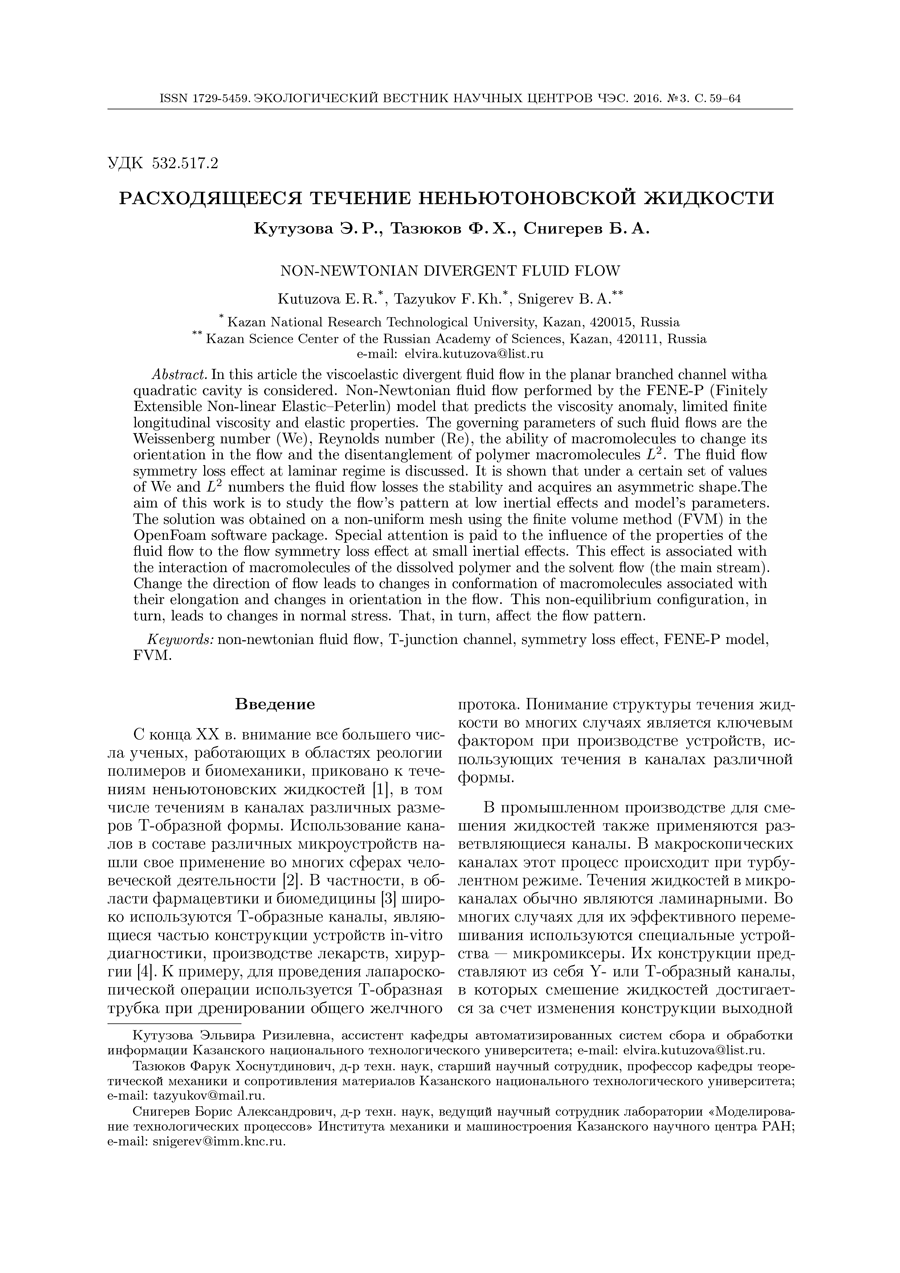Non-newtonian divergent fluid flow
UDC
532.517.2Abstract
In this article the viscoelastic divergent fluid flow in the planar branched channel witha quadratic cavity is considered. Non-Newtonian fluid flow performed by the FENE-P (Finitely Extensible Non-linear Elastic-Peterlin) model that predicts the viscosity anomaly, limited finite longitudinal viscosity and elastic properties. The governing parameters of such fluid flows are the Weissenberg number ($\mathrm{We}$), Reynolds number ($\mathrm{Re}$), the ability of macromolecules to change its orientation in the flow and the disentanglement of polymer macromolecules $L^{2}$. The fluid flow symmetry loss effect at laminar regime is discussed. It is shown that under a certain set of values of $\mathrm{We}$ and $L^{2}$ numbers the fluid flow losses the stability and acquires an asymmetric shape.The aim of this work is to study the flow’s pattern at low inertial effects and model’s parameters. The solution was obtained on a non-uniform mesh using the finite volume method (FVM) in the OpenFoam software package. Special attention is paid to the influence of the properties of the fluid flow to the flow symmetry loss effect at small inertial effects. This effect is associated with the interaction of macromolecules of the dissolved polymer and the solvent flow (the main stream). Change the direction of flow leads to changes in conformation of macromolecules associated with their elongation and changes in orientation in the flow. This non-equilibrium configuration, in turn, leads to changes in normal stress. That, in turn, affect the flow pattern.
Keywords:
non-newtonian fluid flow, T-junction channel, symmetry loss effect, FENE-P model, FVMReferences
- Mukhopadhyay S., Midya C., Layek G.C. Computation of viscous flow field in a tapered artery with an overlapping constriction. International Journal of Fluid Mechanics Research, 2009, vol. 36, no. 4, pp. 343-356.
- Soulages J. et al. Investigating the stability of viscoelastic stagnation flows in T-shaped microchannels. Journal of Non-Newtonian Fluid Mechanics, 2009, vol. 163, no. 1, pp. 9-24.
- Tazyukov F.Kh. et al. Non-Newtonian flow of blood through a symmetric stenosed artery. Russian Journal of Biomechanics, 2012, vol. 16, iss. 1, pp. 46-57.
- Stone H.A., Kim S. Microfluidics: basic issues, applications, and challenges. AIChE Journal, 2001, vol. 47, no. 6, pp. 1250-1254.
- Lobasov A.S., Minakov A.V. Intensifikacija processa smeshenija dvuh zhidkostej v mikrokanalah [Intensification of two fluids mixture process in microchannels]. VII Vserossiskaja konferecija "Molodezh' I nauka: nachalo XXI veka" [VII Russian conference "Youth and scientists: at the beginning of XXI"], 2010. (In Russian)
- Tazyukov F.K., Khalaf H.A., Hassan J.M. Non-newtonian models for blood flow through an arterial stenosis. ASME 2011 International Mechanical Engineering Congress and Exposition, American Society of Mechanical Engineers, 2011, pp. 831-838.
- Khalaf H.A., Tazyukov F.Kh., Aliev K.M. Nelinejnye javlenija pri techenii obobshennoj n'jutonovskoj zhidkosti v ploskom kanale [Nonlinear phenomena at the current of the generalized Newtonian fluid through the planar channel]. Trudy Academenergo [Transaction of academenergo], 2012, no. 1, pp. 44-50. (In Russian)
- Haward S.J., McKinley G.H. Stagnation point flow of wormlike micellar solutions in a microfluidic cross-slot device: Effects of surfactant concentration and ionic environment. Physical Review E, 2012, vol. 85, no. 3, pp. 031502.
- Öztekin A., Alakus B., McKinley G.H. Stability of planar stagnation flow of a highly viscoelastic fluid. Journal of Non-Newtonian Fluid Mechanics, 1997, vol. 72, no. 1, pp. 1-29.
- Baaijens F.P.T. Mixed finite element methods for viscoelastic flow analysis: a review. Journal of Non-Newtonian Fluid Mechanics, 1998, vol. 79, no. 2, pp. 361-385.
Downloads
Issue
Pages
Submitted
Published
How to Cite
Copyright (c) 2016 Kutuzova E.R., Tazyukov F.Kh., Snigerev B.A.

This work is licensed under a Creative Commons Attribution 4.0 International License.




